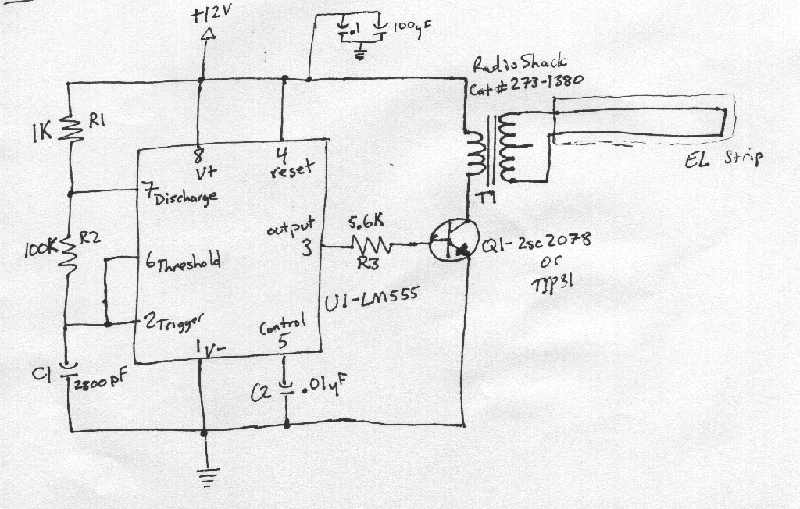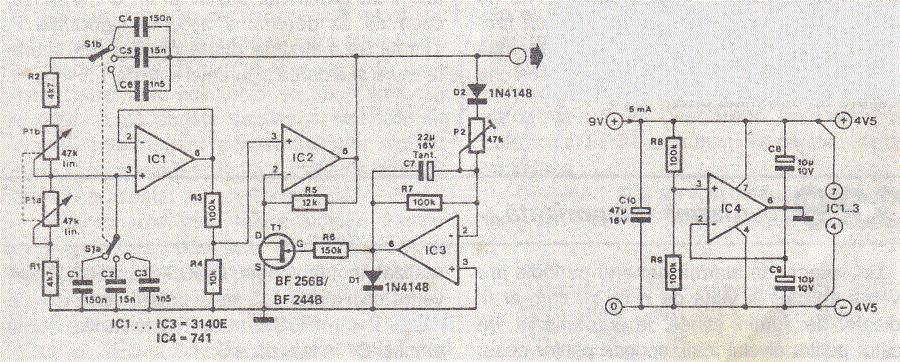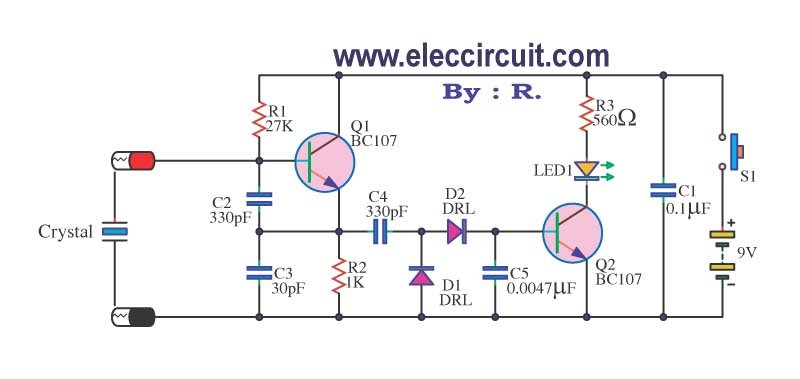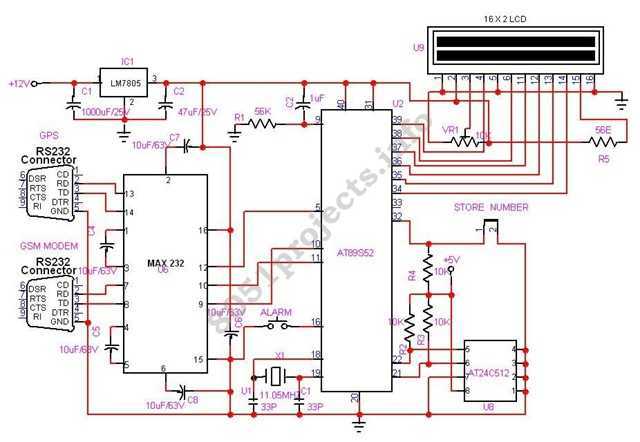
H bridge using TPS2836 and CSD16404
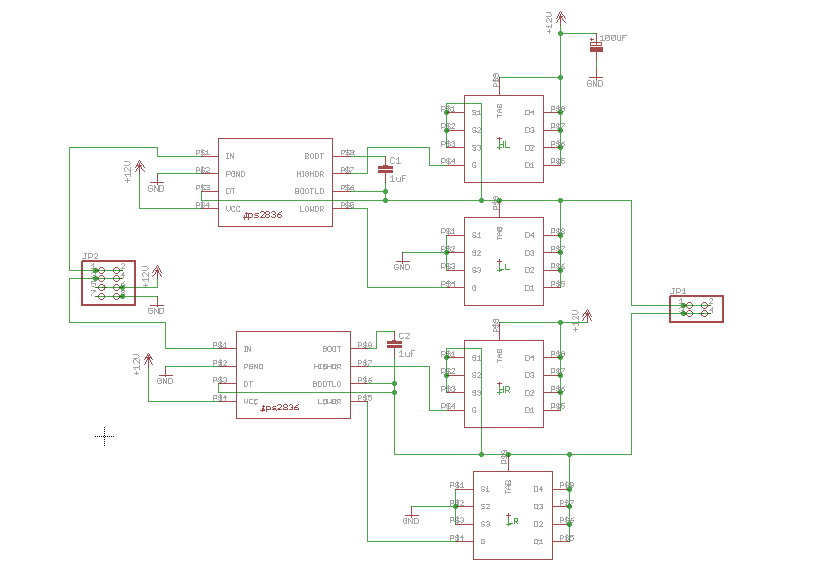
An H-bridge circuit was constructed using the TPS2836 and CSD16404 components. The schematic is provided below. However, the circuit is not functioning correctly, leading to several inquiries regarding potential design flaws. The power supply voltage (VDD-GND) is set to 5V, while input voltages of 3.3V (representing a logical high) and 0V (representing a logical low) are applied to the inputs of the two MOSFET drivers. When attempting to activate the left high-side MOSFET, the voltage at its source measures 4.5V with no load connected to the driver. The overall current consumption of the circuit is approximately 300 mA. Furthermore, when the right bottom MOSFET is activated, the voltage at its drain is around 1.5V instead of the expected zero. It is noted that direct voltage levels are being used at the MOSFET driver inputs instead of a PWM signal. A concern arises regarding whether a pulse train is necessary for the charge pump to function correctly and fully activate the MOSFET. The gate voltage of the left high-side MOSFET is recorded at 5.5V, which is considered low since the CSD16404 requires a VGS of at least 1.8V to turn on. Additionally, when attempting to turn on the right top and left bottom MOSFETs, the circuit draws about 1A, resulting in excessive heating, raising the possibility that the lower right MOSFET may have been damaged during soldering. There is also a question about the necessity of resistors between the MOSFET driver output and the MOSFET gate, which are typically used to control turn-on times. The CSD16404Q5A requires a minimum VGS of 4.5V to ensure proper Rds(on) in the active state. The low-side MOSFET must be pulsed to charge the high-side bootstrap circuit effectively. The TPS2836 driver employs a floating high-side driver, which relies on the BOOTLO voltage (also known as the Switch Node or Phase Node) to maintain the driver’s source voltage. This driver is powered by the BOOT pin through capacitors C1 and C2, which are charged via an internal diode. If the BOOTLO node is high impedance due to the low-side driver being off, the capacitors may not charge adequately. To ensure proper charging, it is advisable to initially activate the low-side driver (LOWDR) for a brief period. Notably, capacitors C1 and C2 should be relatively small, ranging from 0.1 µF to 0.22 µF, as larger capacitors provide minimal benefits and can slow charging rates, leading to startup issues. If the right top and left bottom MOSFETs are activated, resulting in a current draw of around 1A, it may indicate that the low-side device is damaged. Resistance measurements from both BOOTLO pins to ground should be checked when the circuit is unpowered; the internal pull-down resistors should ensure both MOSFETs are off, indicating several Megaohms of resistance is expected. Lastly, the necessity of resistors between the MOSFET driver output and the MOSFET gate, which are not utilized in this circuit, should be clarified, as they are typically implemented to manage turn-on times.
The circuit in question is an H-bridge configuration utilizing the TPS2836 MOSFET driver and CSD16404 MOSFETs. The TPS2836 is designed to drive high- and low-side MOSFETs in a half-bridge configuration, and it requires careful attention to the gate drive voltages to ensure optimal performance. The CSD16404 MOSFET is a N-channel device that requires a gate-source voltage (VGS) of at least 1.8V to turn on effectively, with a recommended minimum of 4.5V for guaranteed Rds(on) performance.
In the described setup, the VDD-GND voltage of 5V is appropriate for powering the TPS2836, but the input signals provided to the MOSFET drivers must be sufficient to ensure that the MOSFETs operate within their specified parameters. The observation that the source voltage of the left high-side MOSFET is 4.5V suggests that the MOSFET is not being fully turned on, as the gate voltage of 5.5V is marginally above the threshold but may not be sufficient for full enhancement, especially under load conditions.
The issue with the right bottom MOSFET showing a drain voltage of 1.5V indicates that it may not be fully turning off or that there could be a fault within the device, possibly due to overheating or damage from soldering. The excessive current draw of 1A when both the right top and left bottom MOSFETs are activated is concerning and suggests that there may be a short circuit or misconfiguration in the circuit.
The TPS2836's floating high-side driver architecture relies on the BOOT capacitor charging to provide the necessary gate drive voltage for the high-side MOSFET. If the low-side MOSFET is not pulsed on initially, the BOOT capacitors (C1 and C2) may not charge adequately, resulting in insufficient gate drive voltage for the high-side MOSFET. It is essential to ensure that these capacitors are within the specified range to avoid startup issues.
In conclusion, a thorough review of the circuit design, including the implementation of the MOSFET drivers, the gate drive voltages, and the presence of any potential faults in the MOSFETs, is necessary to resolve the issues encountered. Additionally, the role of resistors between the driver output and MOSFET gates should be evaluated based on the specific requirements of the application, as they can influence the switching characteristics and performance of the circuit.I made an hbridge using TPS2836 and CSD16404. The schematic is shown below. It does not work properly and I have a few questions about it. It would be great if you can point out where the design is wrong. 1. I gave a VDD-GND of 5V and tried to give the voltages 3. 3V (signifying a logical 1) and 0V (signifying a logical 0) to the inputs of the two mosfet drivers. When I try to turn on the left-high side mosfet, the voltage at it`s source is 4. 5V with no load attached to the driver. The current drawn by the whole circuit is also almost 300 mA. Simultaneously, if the right bottom mosfet is turned on, the voltage at it`s drain is not zero but something around 1. 5V. Note that I am not giving a PWM to the inputs of the mosfet driver but direct voltage levels. Should there be a pulse train coming in to let the charge pump function properly and fully turn on the mosfet The voltage at the gate of left-high mosfet is 5.
5V which is pretty low, when the CSD16404 turns on only at VGS = 1. 8V. 2. If I try to turn on the right top mosfet and the left-bottom mosfet, the whole circuit draws some 1A and things begin to heat up! It could be that the lower-right mosfet is smoked while / after soldering right 3. Are the resistors between the mosfet driver output and the mosfet gate (not used in this circuit) essential for the functioning They are only used to control the turn on times right 1) The CSD16404Q5A must be driven with at least 4.
5 volt Vgs to guarantee the Rds(on) in the on state. The low side MOSFET needs to be pulsed to charge the high side bootstrap circuit with these types of MOSFET drivers. 1. I gave a VDD-GND of 5V and tried to give the voltages 3. 3V (signifying a logical 1) and 0V (signifying a logical 0) to the inputs of the two mosfet drivers. When I try to turn on the left-high side mosfet, the voltage at it`s source is 4. 5V with no load attached to the driver. The current drawn by the whole circuit is also almost 300 mA. Simultaneously, if the right bottom mosfet is turned on, the voltage at it`s drain is not zero but something around 1.
5V. Note that I am not giving a PWM to the inputs of the mosfet driver but direct voltage levels. Should there be a pulse train coming in to let the charge pump function properly and fully turn on the mosfet The voltage at the gate of left-high mosfet is 5. 5V which is pretty low, when the CSD16404 turns on only at VGS = 1. 8V. The TPS2836 driver uses a floating high-side driver. The high-side driver "floats" on the BOOTLO voltage (also called the Switch Node or Phase Node) such that the driver is always seeing the source voltage of the high-side MOSFET.
This driver is powered from the BOOT pin by the BOOTLO to BOOT capacitor (C1 and C2) which are charged through an internal diode through, however if the BOOTLO node is high impedance (low-side drive has not been turned on) the capacitors will not charge properly. It is best to charge these capacitors by turning on the low-side driver (LOWDR) for a short period initially to charge these capacitors.
Note: C1 and C2 are extremely large for this application. This capacitor need only be 0. 1uF - 0. 22uF. Larger capacitors in these locations offer very little benefit, but can slow their initial charge rate and result in start-up issues. 2. If I try to turn on the right top mosfet and the left-bottom mosfet, the whole circuit draws some 1A and things begin to heat up!
It could be that the lower-right mosfet is smoked while / after soldering right It`s possible that the low-side device is damaged. Check the resistance from both BOOTLO pins to GND when the circuit is unpowered. The internal pull-down resistors should force both MOSFETs off, so one would expect several MegOhms of resistance.
3. Are the resistors between the mosfet driver output and the mosfet gate (not used in this circuit) essential for the functioning They are only used to control the turn on times right Gate Driv 🔗 External reference
The circuit in question is an H-bridge configuration utilizing the TPS2836 MOSFET driver and CSD16404 MOSFETs. The TPS2836 is designed to drive high- and low-side MOSFETs in a half-bridge configuration, and it requires careful attention to the gate drive voltages to ensure optimal performance. The CSD16404 MOSFET is a N-channel device that requires a gate-source voltage (VGS) of at least 1.8V to turn on effectively, with a recommended minimum of 4.5V for guaranteed Rds(on) performance.
In the described setup, the VDD-GND voltage of 5V is appropriate for powering the TPS2836, but the input signals provided to the MOSFET drivers must be sufficient to ensure that the MOSFETs operate within their specified parameters. The observation that the source voltage of the left high-side MOSFET is 4.5V suggests that the MOSFET is not being fully turned on, as the gate voltage of 5.5V is marginally above the threshold but may not be sufficient for full enhancement, especially under load conditions.
The issue with the right bottom MOSFET showing a drain voltage of 1.5V indicates that it may not be fully turning off or that there could be a fault within the device, possibly due to overheating or damage from soldering. The excessive current draw of 1A when both the right top and left bottom MOSFETs are activated is concerning and suggests that there may be a short circuit or misconfiguration in the circuit.
The TPS2836's floating high-side driver architecture relies on the BOOT capacitor charging to provide the necessary gate drive voltage for the high-side MOSFET. If the low-side MOSFET is not pulsed on initially, the BOOT capacitors (C1 and C2) may not charge adequately, resulting in insufficient gate drive voltage for the high-side MOSFET. It is essential to ensure that these capacitors are within the specified range to avoid startup issues.
In conclusion, a thorough review of the circuit design, including the implementation of the MOSFET drivers, the gate drive voltages, and the presence of any potential faults in the MOSFETs, is necessary to resolve the issues encountered. Additionally, the role of resistors between the driver output and MOSFET gates should be evaluated based on the specific requirements of the application, as they can influence the switching characteristics and performance of the circuit.I made an hbridge using TPS2836 and CSD16404. The schematic is shown below. It does not work properly and I have a few questions about it. It would be great if you can point out where the design is wrong. 1. I gave a VDD-GND of 5V and tried to give the voltages 3. 3V (signifying a logical 1) and 0V (signifying a logical 0) to the inputs of the two mosfet drivers. When I try to turn on the left-high side mosfet, the voltage at it`s source is 4. 5V with no load attached to the driver. The current drawn by the whole circuit is also almost 300 mA. Simultaneously, if the right bottom mosfet is turned on, the voltage at it`s drain is not zero but something around 1. 5V. Note that I am not giving a PWM to the inputs of the mosfet driver but direct voltage levels. Should there be a pulse train coming in to let the charge pump function properly and fully turn on the mosfet The voltage at the gate of left-high mosfet is 5.
5V which is pretty low, when the CSD16404 turns on only at VGS = 1. 8V. 2. If I try to turn on the right top mosfet and the left-bottom mosfet, the whole circuit draws some 1A and things begin to heat up! It could be that the lower-right mosfet is smoked while / after soldering right 3. Are the resistors between the mosfet driver output and the mosfet gate (not used in this circuit) essential for the functioning They are only used to control the turn on times right 1) The CSD16404Q5A must be driven with at least 4.
5 volt Vgs to guarantee the Rds(on) in the on state. The low side MOSFET needs to be pulsed to charge the high side bootstrap circuit with these types of MOSFET drivers. 1. I gave a VDD-GND of 5V and tried to give the voltages 3. 3V (signifying a logical 1) and 0V (signifying a logical 0) to the inputs of the two mosfet drivers. When I try to turn on the left-high side mosfet, the voltage at it`s source is 4. 5V with no load attached to the driver. The current drawn by the whole circuit is also almost 300 mA. Simultaneously, if the right bottom mosfet is turned on, the voltage at it`s drain is not zero but something around 1.
5V. Note that I am not giving a PWM to the inputs of the mosfet driver but direct voltage levels. Should there be a pulse train coming in to let the charge pump function properly and fully turn on the mosfet The voltage at the gate of left-high mosfet is 5. 5V which is pretty low, when the CSD16404 turns on only at VGS = 1. 8V. The TPS2836 driver uses a floating high-side driver. The high-side driver "floats" on the BOOTLO voltage (also called the Switch Node or Phase Node) such that the driver is always seeing the source voltage of the high-side MOSFET.
This driver is powered from the BOOT pin by the BOOTLO to BOOT capacitor (C1 and C2) which are charged through an internal diode through, however if the BOOTLO node is high impedance (low-side drive has not been turned on) the capacitors will not charge properly. It is best to charge these capacitors by turning on the low-side driver (LOWDR) for a short period initially to charge these capacitors.
Note: C1 and C2 are extremely large for this application. This capacitor need only be 0. 1uF - 0. 22uF. Larger capacitors in these locations offer very little benefit, but can slow their initial charge rate and result in start-up issues. 2. If I try to turn on the right top mosfet and the left-bottom mosfet, the whole circuit draws some 1A and things begin to heat up!
It could be that the lower-right mosfet is smoked while / after soldering right It`s possible that the low-side device is damaged. Check the resistance from both BOOTLO pins to GND when the circuit is unpowered. The internal pull-down resistors should force both MOSFETs off, so one would expect several MegOhms of resistance.
3. Are the resistors between the mosfet driver output and the mosfet gate (not used in this circuit) essential for the functioning They are only used to control the turn on times right Gate Driv 🔗 External reference

